Abstract
The purpose of this study was to determine whether grain handlers underwent work-related changes in their pulmonary function and, if so, to examine the dose-effect relationships with dust exposure. The pulmonary function of grain handlers was measured at the beginning and end of work shifts over a period of one week, during which their exposure to dust was measured daily. The results showed changes indicative of a within-day obstructive change, in addition to a small restrictive defect occurring over the course of a week. Civic outside labourers who were examined as a control group showed a similar within-week obstructive change without any associated restriction of lung volume. The data on the grain handlers were also used to examine the dose-effect relationships of dust exposure, both on baseline pulmonary function and on within-day changes in these measurements. The baseline flow rates of workers who did not wear a mask were found to vary inversely with their average exposure to respirable dust. In addition, the flow rates underwent a within-day decrease that varied directly with their corresponding exposure to respirable dust and was unrelated to mask wearing. The median of the slopes for this relationship indicated that 50% of the subjects had a decrease of at least 923 ml/s in the value of their Vmax50%VC for each 1 mg/m3 increase in the concentration of respirable dust. Non-respirable dust did not have a measurable effect either on the baseline or the within-day changes in pulmonary function. The acute changes were unaffected by age, duration of employment, or extent of smoking.
Full text
PDF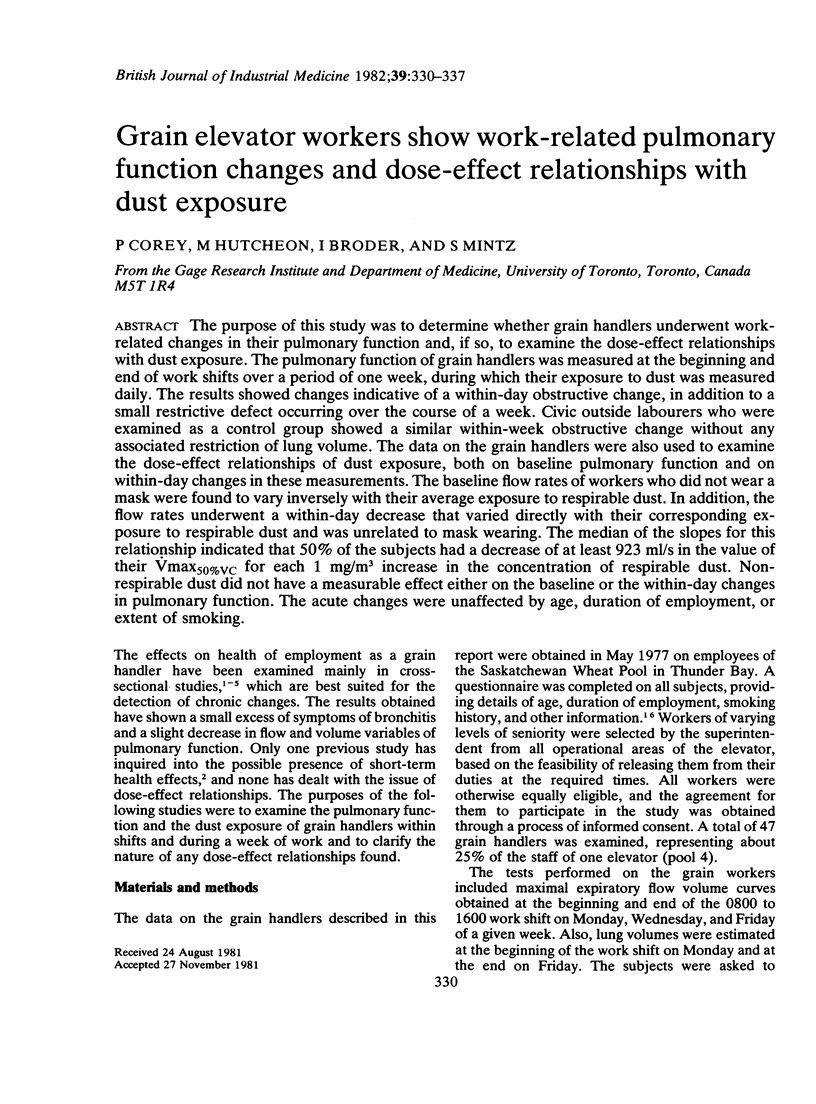
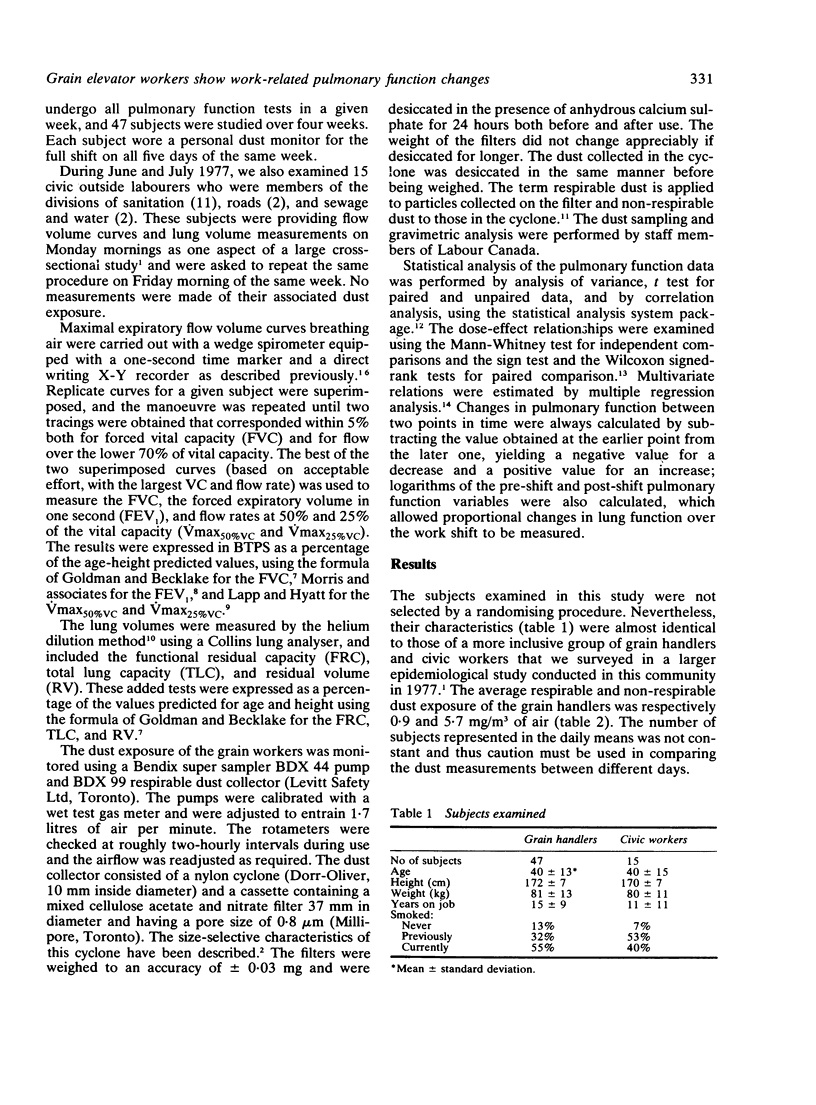
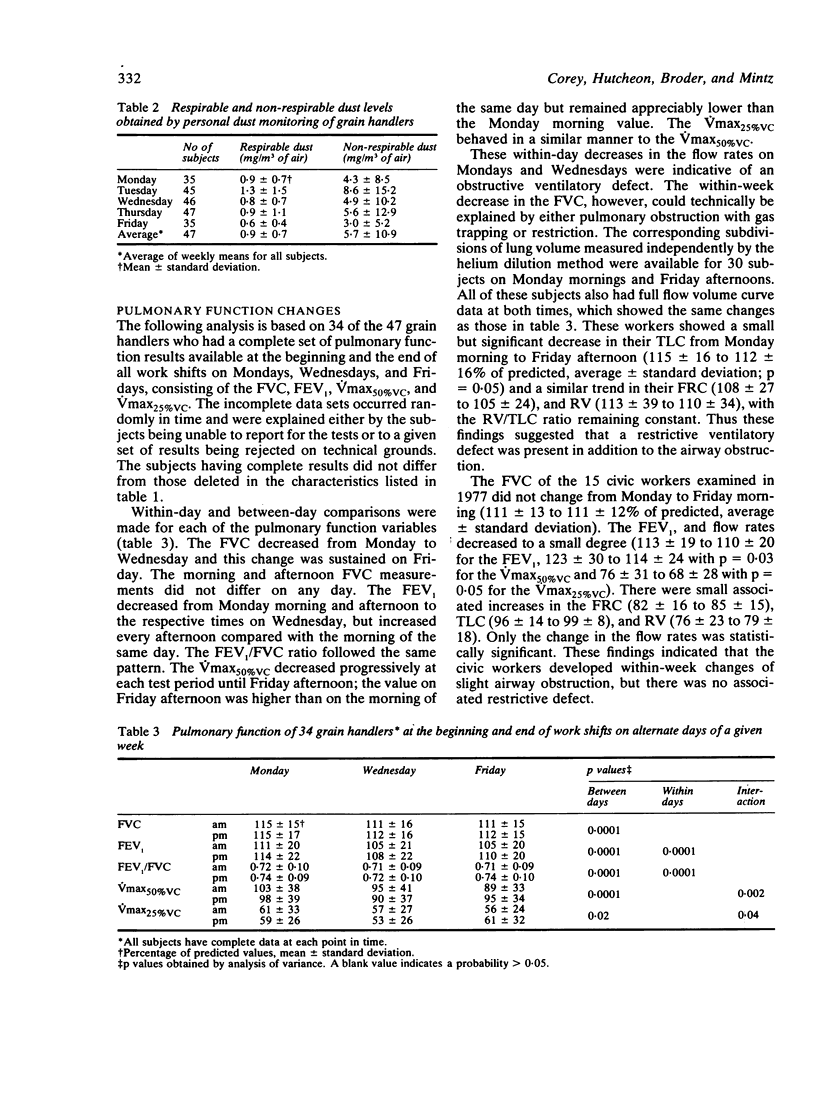
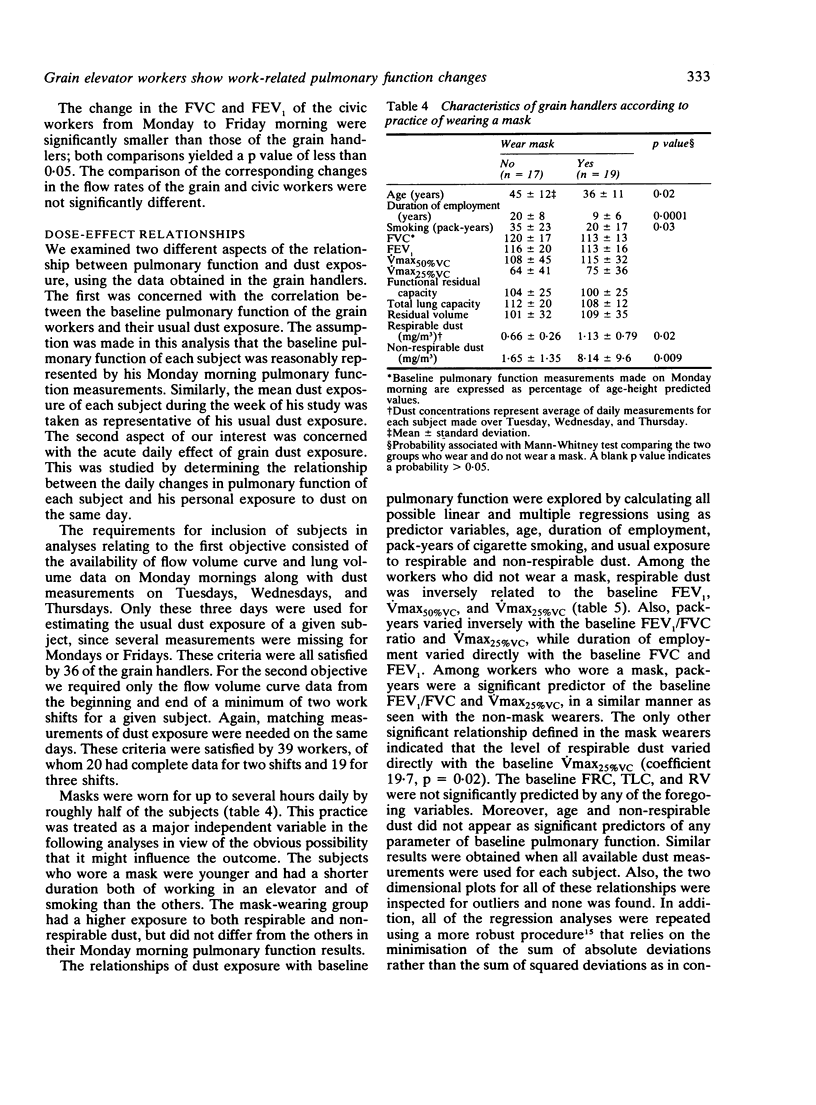
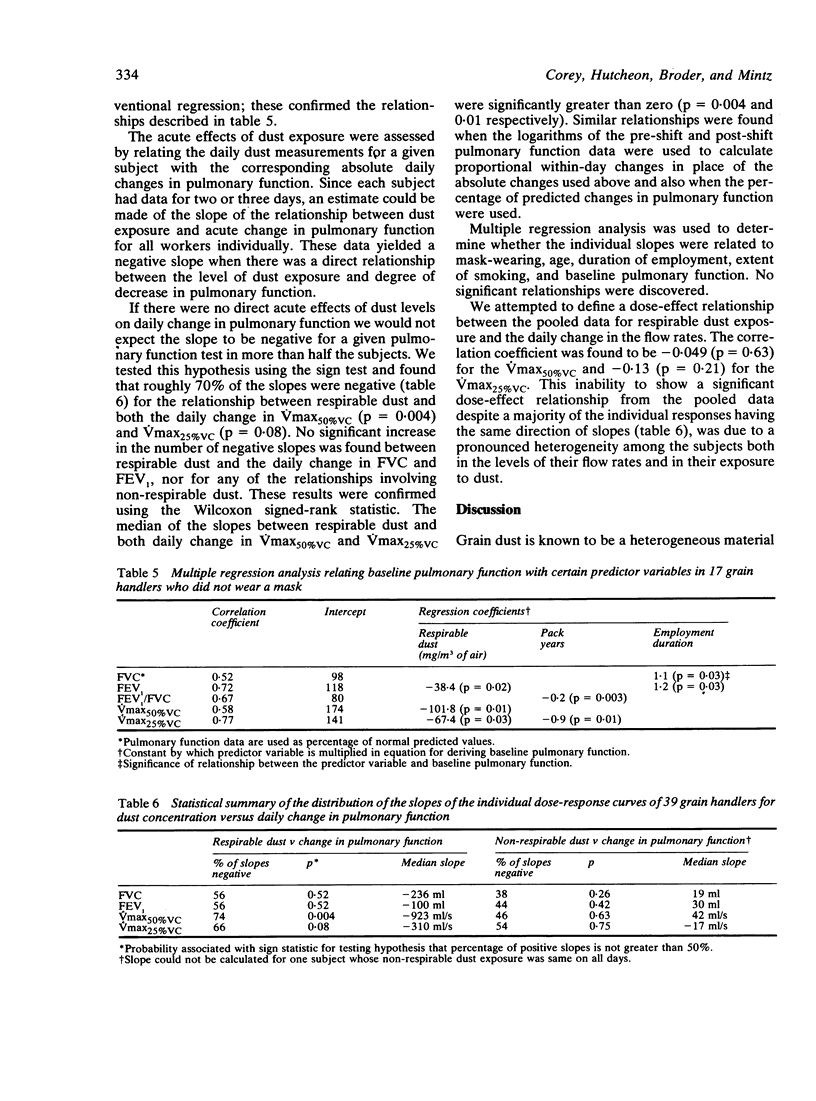
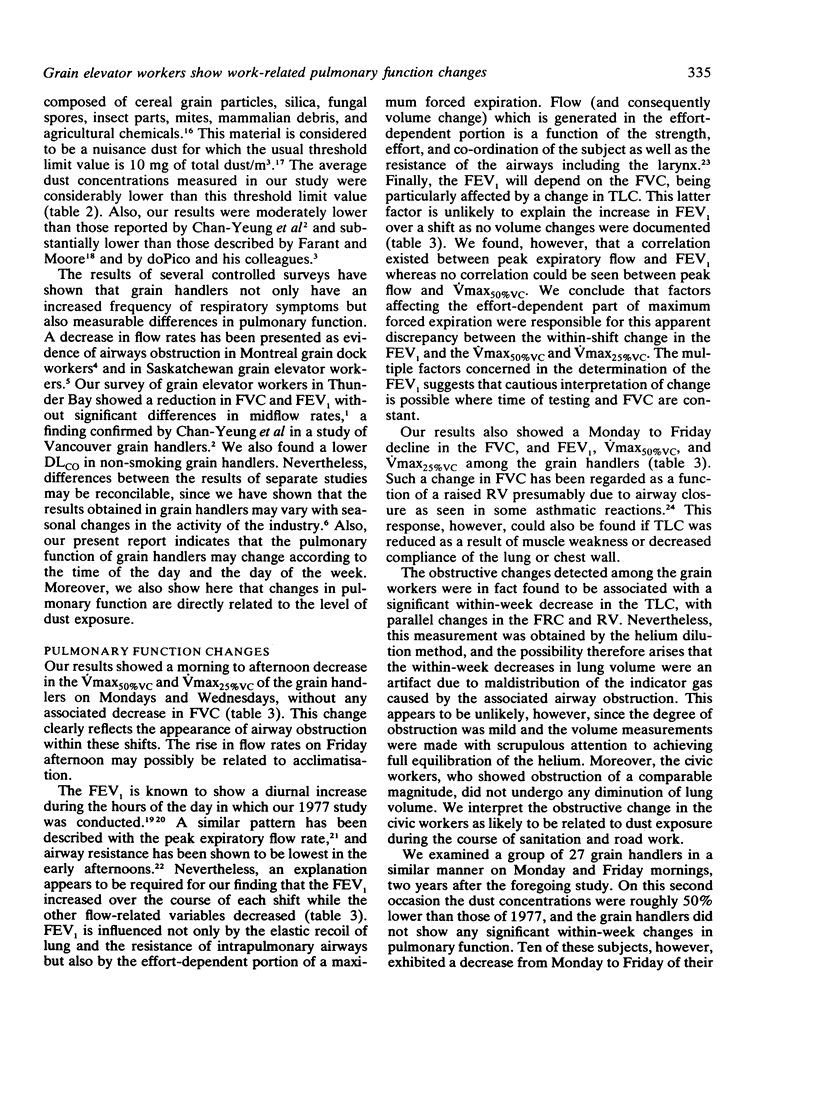
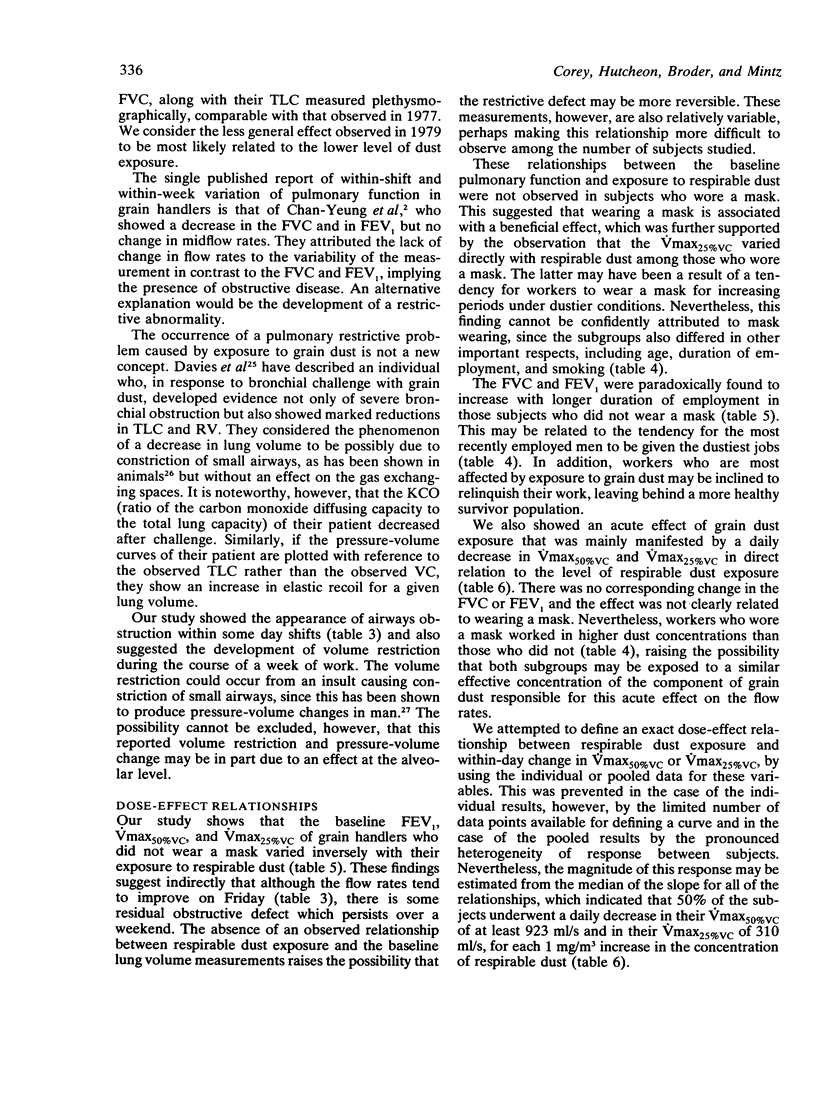
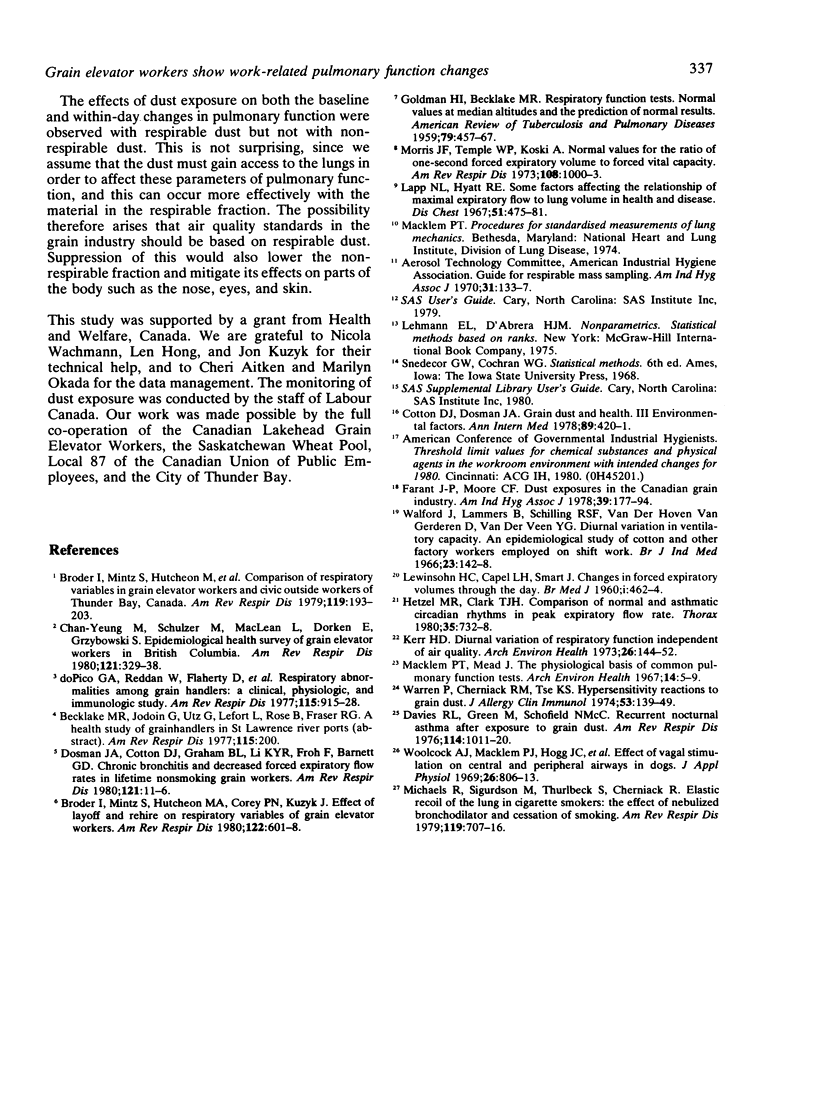
Selected References
These references are in PubMed. This may not be the complete list of references from this article.
- Broder I., Mintz S., Hutcheon M. A., Corey P. N., Kuzyk J. Effect of layoff and rehire on respiratory variables of grain elevator workers. Am Rev Respir Dis. 1980 Oct;122(4):601–608. doi: 10.1164/arrd.1980.122.4.601. [DOI] [PubMed] [Google Scholar]
- Broder I., Mintz S., Hutcheon M., Corey P., Silverman F., Davies G., Leznoff A., Peress L., Thomas P. Comparison of respiratory variables in grain elevator workers and civic outside workers of Thunder Bay, Canada. Am Rev Respir Dis. 1979 Feb;119(2):193–203. doi: 10.1164/arrd.1979.119.2.193. [DOI] [PubMed] [Google Scholar]
- Chan-Yeung M., Schulzer M., MacLean L., Dorken E., Grzybowski S. Epidemiologic health survey of grain elevator workers in British Columbia. Am Rev Respir Dis. 1980 Feb;121(2):329–338. doi: 10.1164/arrd.1980.121.2.329. [DOI] [PubMed] [Google Scholar]
- Cotton D. J., Dosman J. A. Grain dust and health. III. Environmental factors. Ann Intern Med. 1978 Sep;89(3):420–421. doi: 10.7326/0003-4819-89-3-420. [DOI] [PubMed] [Google Scholar]
- DoPico G. A., Reddan W., Flaherty D., Tsiatis A., Peters M. E., Rao P., Rankin J. Respiratory abnormalities among grain handlers: a clinical, physiologic, and immunologic study. Am Rev Respir Dis. 1977 Jun;115(6):915–927. doi: 10.1164/arrd.1977.115.6.915. [DOI] [PubMed] [Google Scholar]
- Dosman J. A., Cotton D. J., Graham B. L., Li K. Y., Froh F., Barnett G. D. Chronic bronchitis and decreased forced expiratory flow rates in lifetime nonsmoking grain workers. Am Rev Respir Dis. 1980 Jan;121(1):11–16. doi: 10.1164/arrd.1980.121.1.11. [DOI] [PubMed] [Google Scholar]
- Farant J. P., Moore C. F. Dust exposures in the Canadian grain industry. Am Ind Hyg Assoc J. 1978 Mar;39(3):177–194. doi: 10.1080/0002889778507741. [DOI] [PubMed] [Google Scholar]
- GOLDMAN H. I., BECKLAKE M. R. Respiratory function tests; normal values at median altitudes and the prediction of normal results. Am Rev Tuberc. 1959 Apr;79(4):457–467. doi: 10.1164/artpd.1959.79.4.457. [DOI] [PubMed] [Google Scholar]
- Hetzel M. R., Clark T. J. Comparison of normal and asthmatic circadian rhythms in peak expiratory flow rate. Thorax. 1980 Oct;35(10):732–738. doi: 10.1136/thx.35.10.732. [DOI] [PMC free article] [PubMed] [Google Scholar]
- Kerr H. D. Diurnal variation of respiratory function independent of air quality: experience with an environmentally controlled exposure chamber for human subjects. Arch Environ Health. 1973 Mar;26(3):144–152. doi: 10.1080/00039896.1973.10666242. [DOI] [PubMed] [Google Scholar]
- LEWINSOHN H. C., CAPEL L. H., SMART J. Changes in forced expiratory volumes throughout the day. Br Med J. 1960 Feb 13;1(5171):462–464. doi: 10.1136/bmj.1.5171.462. [DOI] [PMC free article] [PubMed] [Google Scholar]
- Lapp N. L., Hyatt R. E. Some factors affecting the relationship of maximal expiratory flow to lung volume in health and disease. Dis Chest. 1967 May;51(5):475–481. doi: 10.1378/chest.51.5.475. [DOI] [PubMed] [Google Scholar]
- Macklem P. T., Mead J. The physiological basis of common pulmonary function tests. Arch Environ Health. 1967 Jan;14(1):5–9. doi: 10.1080/00039896.1967.10664685. [DOI] [PubMed] [Google Scholar]
- Michaels R., Sigurdson M., Thurlbeck S., Cherniack R. Elastic recoil of the lung in cigarette smokers: the effect of nebulized bronchodilator and cessation of smoking. Am Rev Respir Dis. 1979 May;119(5):707–716. doi: 10.1164/arrd.1979.119.5.707. [DOI] [PubMed] [Google Scholar]
- Morris J. F., Temple W. P., Koski A. Normal values for the ratio of one-second forced expiratory volume to forced vital capacity. Am Rev Respir Dis. 1973 Oct;108(4):1000–1003. doi: 10.1164/arrd.1973.108.4.1000. [DOI] [PubMed] [Google Scholar]
- Walford J., Lammers B., Schilling R. S., Hoven van Genderen D., van der Veen Y. G. Diurnal variation in ventilatory capacity. An epidemiological study of cotton and other factory workers employed on shift work. Br J Ind Med. 1966 Apr;23(2):142–148. doi: 10.1136/oem.23.2.142. [DOI] [PMC free article] [PubMed] [Google Scholar]
- Warren P., Cherniack R. M., Tse K. S. Hypersensitivity reactions to grain dust. J Allergy Clin Immunol. 1974 Mar;53(3):139–149. doi: 10.1016/0091-6749(74)90002-5. [DOI] [PubMed] [Google Scholar]
- Woolcock A. J., Macklem P. T., Hogg J. C., Wilson N. J., Nadel J. A., Frank N. R., Brain J. Effect of vagal stimulation on central and peripheral airways in dogs. J Appl Physiol. 1969 Jun;26(6):806–813. doi: 10.1152/jappl.1969.26.6.806. [DOI] [PubMed] [Google Scholar]


